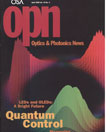
April 1999 Issue
- High Efficiency LEDS A Bright New Light Source Joins the Lighting Industry
- Aluminum Composite Cathodes A New Method for the Fabrication of Efficient and Bright Organic Light-emitting Devices
- Measuring Ultrafast Optical Pulses Using Spectral Interferometry
- Optics Inside an Atom
- The Shack-Hartmann Wavefront Sensor
- Wide-angle DMD Projection Lens
- Browse all Issues
Feature Articles
High Efficiency LEDS A Bright New Light Source Joins the Lighting Industry
Light emitting diodes are beginning to dominate the lighting industry. This article examines the history and science behind LEDs and previews their bright future.
by Robert FletcherAluminum Composite Cathodes A New Method for the Fabrication of Efficient and Bright Organic Light-emitting Devices
Organic light-emitting devices are an exciting addition to the field of display technology. Jabbour and colleagues present a new approach to fabricating OLEDs that provides an order of magnitude performance improvement and simplified device geometry.
by G.E. Jabbour, S.E. Shaheen, M.M. Morrell, B. Kippelen, N.R. Armstrong, and N. PeyghambarianMeasuring Ultrafast Optical Pulses Using Spectral Interferometry
Spectral interferometry promises to continue the revolution in measuring ultrashort optical pulses through sensitive, high precision phase measurement and robust and rapid data inversion.
by Ian A. WalmsleyOptics Inside an Atom
This article provides a brief overview of atom interferometry, noting what's been learned about the behavior of atoms using the technique and describing applications in fields such as chemistry and computing.
by C.R. Stroud, JR., Michael W. NoelThe Shack-Hartmann Wavefront Sensor
Roland Shack invented the device now known as the Shack-Hartmann wavefront sensor in the early 1970s. This sensor, which has in recent years been commercialized, measures the phase distribution over the cross-section of a given beam of light without relying on optical interference and, therefore, does not require a reference beam.
by Masud MansuripurWide-angle DMD Projection Lens
Projectors using two digital micro-mirror devices (DMDs) chips were developed to take advantage of long-lifetime, short-arc metal halide lamps that have recently become available. These lamps emit much more light in the blue-green portion of the visible spectrum than in the red portion. Two chip projection systems can effectively use this type of lamp by splitting the spectrum into a red portion and a blue-green portion using dichroic filters.
by J. Brian Caldwell

![A multiplexed image of a human tonsil acquired. [NIAID] using the iterative bleaching extends multiplexity (IBEX) method.](https://opnmedia.blob.core.windows.net/$web/opn/media/images/articles/2024/0424/departments/202404-cover-web.jpg?ext=.jpg)
